It’s neither easy nor politically correct to build the most powerful streetbike ever offered to the public for mass consumption, but that’s what Kawasaki has done with the incredibly potent new ZX-14R.
The ZX-14 has been a major player in the hyperbike wars since its introduction in 2006, becoming the only machine that could hold a candle to Suzuki’s mega-powerful (nearly 160 hp) Hayabusa that was introduced back in 1999. The ZX-14 cranked out a remarkable 171 hp on the dyno and must’ve worried Suzuki’s marketing department and engineering team, as they released a more powerful Hayabusa in 2008 with a bigger engine that produced around 165 horses.
Kawasaki surprised us with a revised ZX-14 in 2008, just two years since its debut, to meet the revitalized Suzuki challenger. While the Kawi remained the smoother and more accommodating choice, emissions regulations took a chunk out of the ZX’s top-end performance. Running excessively rich to preserve its catalyzers, the ZX spat out 10 peak horses less than the original.
This obviously didn’t sit well with Kawasaki, so they’ve now responded with the ZX-14R for 2012. Note the addition of the R to its name. Kawi’s engineers made a host of upgrades to the ZX’s powerplant, most notably by adding 4mm to the engine’s stroke that ups displacement from 1352cc to 1441cc. This 6.5% size increase plus hot-rodding tricks like hand-finished intake ports, more radical camshaft specs, a compression ratio increase and tapered exhaust headers has resulted in what Kawasaki claims is the most powerful mass-produced motorcycle engine in the world.
“When you dyno it,” ace dragracing champ Rickey Gadson told us, “get a Gen II ’Busa at the same time, because you’re not gonna believe what you see.”
How powerful is it? We won’t know for sure until we test it for ourselves, but we’re led to believe it’ll spin a dyno drum to the tune of at least 185 hp, perhaps even 190. If true, the Hayabusa’s big-hitter status just got severely demoted. “On the ZX-14R,” Kawi’s press material boasts, “total domination is just a twist of the throttle away.”
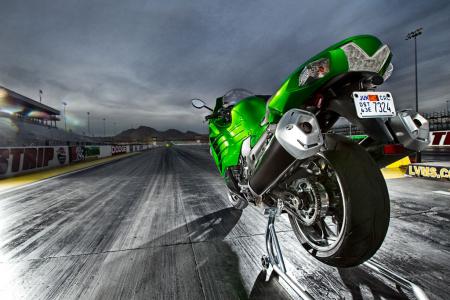 |
To put the new 14R to the test, Kawasaki brought us out to Nevada for a two-stage performance. We spent the morning riding deserted desert roads, following it up with an afternoon on The Strip at Las Vegas Motor Speedway. Much exhilaration ensued, all without the exchange of dollar bills.
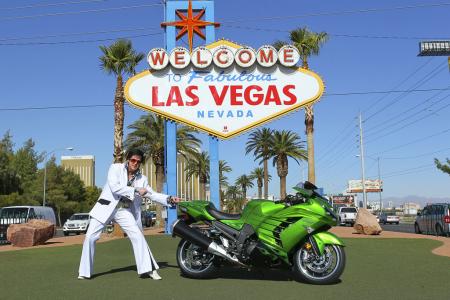 The King of Rock ‘n’ Roll Meets the King of the (drag) strip. The King of Rock ‘n’ Roll Meets the King of the (drag) strip. |
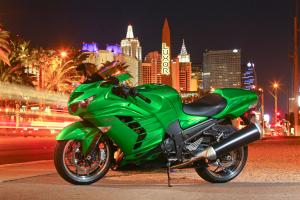 Seeing the 14R in person, its impressiveness is the dominant impression. It’s a big machine, and big things of any kind have a difficulty in appearing beautiful. But the biggest ZX certainly looks the part of a powerful and fast machine.
Seeing the 14R in person, its impressiveness is the dominant impression. It’s a big machine, and big things of any kind have a difficulty in appearing beautiful. But the biggest ZX certainly looks the part of a powerful and fast machine. Up front, its intimidating quad-headlamp design receives an update, bisected by a larger ram-air induction scoop. The 14’s distinctive Testarossa-like strakes along the fairing sides are retooled, part of functional improvements including larger ducting that routes engine heat away from a rider. Unseen is the addition of an added cooling fan for the radiator. Flush-mounted, clear-lens turnsignals help streamline its looks, and much effort has been spent to make the bodywork fasteners almost invisible. The streamlined tail section culminates with a smooth V-shaped clear taillight lens, and a seat cowl is included as standard equipment. The bike’s back half is dominated by howitzer-sized mufflers that are, again, impressive, but not quite pretty. However, their large volume helps generate power while meeting noise restrictions.
Rocket pilot, Meet Your Cockpit
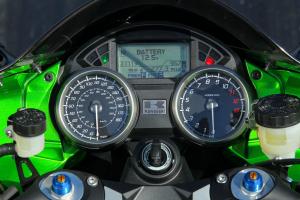 Instrumentation gets updates for 2012. Instrumentation gets updates for 2012. |
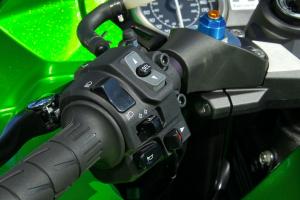 Alternate info screen displays and power- and traction-controls settings can be adjusted via new handlebar switchgear. Alternate info screen displays and power- and traction-controls settings can be adjusted via new handlebar switchgear. |
Instrumentation is thorough. An analog tach and speedo are ringed by stainless-steel trim, while an LCD info screen resides in between. Displays for fuel economy, fuel range and gear position are retained, now also joined by an air temperature gauge and a display for the ECU’s eco mode that turns on when ridden lightly – Kawi claims up to a 20% increase in low-speed fuel economy. Best of all, the displays can easily be toggled via new switchgear on the left handlebar.
The info screen also keeps tabs on the 14R’s new traction-control system and power-management settings. The Low power mode can be selected when full boost isn’t desirable, lopping off output beginning at 6500 rpm to a 25% deficiency at its top end.
More interesting is the traction-control aspect. Mode 3 works similar to the Concours KTRC arrangement, giving sure grip in low-traction situations. Modes 1 and 2 are like the S-KTRC system in the ZX-10R, so they’re not very intrusive. In fact, Mode 1 performs so well at the dragstrip, even a pro like Gadson can only go about a tenth of a second quicker down a strip with TC turned off. Your results will vary – greatly.
Warm Up
A new Idle Speed Control valve automatically adjusts idle levels depending on engine temperature, and it’s also said to lower emissions during deceleration to allow for smaller catalyzers that unleash more power. The 14R is amazingly docile at slow speeds for the fastest-accelerating production motorcycle in the world. Its radial-pump clutch is a doddle to modulate, and low-speed fueling is glitch-free. A wide steering sweep yields greater maneuverability than expected for such a long bike.
But docile won’t be the word rolling around in your brain once you’ve pinned the 14R’s throttle. The engine’s extra cubes give it a little extra low-end torque, but the party really begins around 6500 rpm when the Kaw unleashes a Herculean wallop that doesn’t end until past 11,000 rpm, which is around the time you’re wondering if your eyeballs are now actually retracted to the point of touching your cerebral cortex.
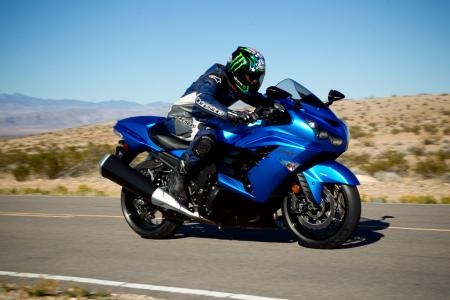 Even the open deserts of Nevada are too small for hyperspeed ZX-14R. Even the open deserts of Nevada are too small for hyperspeed ZX-14R. |
Twist Me
The many changes made to the 14R add up on the scales, gaining 17 pounds in the process to its 549-lb tank-empty weight. Add another 35 pounds with its reasonably sized 5.8-gallon tank topped off. Some blame for the extra lard goes to its more complicated bodywork, while many additional grams are made of metal, such as a new steering stem section on its aluminum frame for optimized rigidity balance and a 10mm longer aluminum swingarm, the latter stretching wheelbase by 0.8 inch to 58.3 inches.
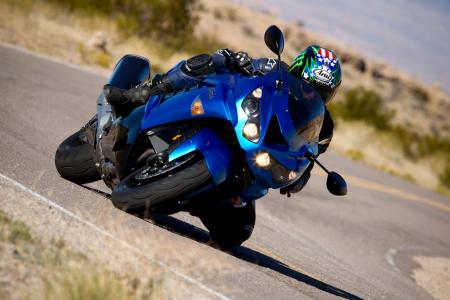 The ZX-14’s handling performance has improved with the R model. Knee-dragging angles of lean are available without digging in the comfortably set footpegs. The ZX-14’s handling performance has improved with the R model. Knee-dragging angles of lean are available without digging in the comfortably set footpegs. |
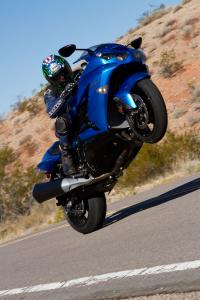 More weight and a longer wheelbase sounds like it would result in a Cow-asaki on a twisty road, but that’s not how it performs despite identical steering geometry. Credit goes to new 10-spoke wheels that cut 3.3 pounds of unsprung rotational mass from the previous hoops. If anything, the 14R turns at least as quickly as the ZX-14. Metzeler M5 Sportec tires supply good grip.
More weight and a longer wheelbase sounds like it would result in a Cow-asaki on a twisty road, but that’s not how it performs despite identical steering geometry. Credit goes to new 10-spoke wheels that cut 3.3 pounds of unsprung rotational mass from the previous hoops. If anything, the 14R turns at least as quickly as the ZX-14. Metzeler M5 Sportec tires supply good grip. Quick At The Strip
I grew up as a fan of roadracing, so dragracing used to seem boring to me. Not anymore! This was now my third time aboard a ZX-14 at the strip, and it’s always proven to be super exciting and intensely complex, as a rider endlessly struggles to gain tenths of a second, then hundredths. Our time at The Strip on the 14R confirmed that impression.
It’s the launch that determines 90% of any run down the quarter-mile, and the ZX’s excellent clutch and torquey motor makes it as easy as possible for a bike with perhaps 210 crankshaft horsepower. On my first full run down the strip, I clocked a 9.91 ET while going through the traps at nearly 148 mph – this is a serious dragstrip weapon!
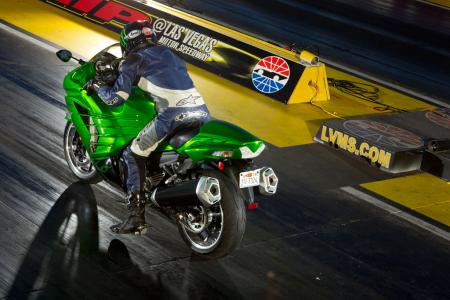 Wanna go fast in a straight line? The ZX-14R will get you from a dead stop to 150 mph in less than 1400 feet! Wanna go fast in a straight line? The ZX-14R will get you from a dead stop to 150 mph in less than 1400 feet! |
None of us would’ve gone as quick as we did without the expert coaching from Gadson. Anyone interested in learning about the art of dragracing should look up the website for Rickey’s school. Amazingly, he advised us to launch with just 3000-3400 rpm on the tach, aided by a launch lamp that’s programmable to any rpm zone. This sounded like an absurdly low amount of revs for a high-G start, but the R’s torquier new mill easily pulled it off.
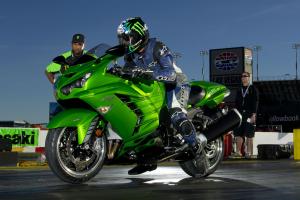 When I got the balance between the clutch lever and throttle just right, I knocked out a best run of 9.77 seconds at 148.9 mph. This is an impressive stat for a bone-stock production bike, but it’s even more remarkable when the atmospheric conditions are factored in. The dry desert air combined with the track’s 1800-foot altitude equated to a 3000-foot elevation. Corrected to sea-level conditions, our times would drop by about 2.5 tenths of a second. Under ideal conditions, a 9.5-second ET is within the realm of possibility!
When I got the balance between the clutch lever and throttle just right, I knocked out a best run of 9.77 seconds at 148.9 mph. This is an impressive stat for a bone-stock production bike, but it’s even more remarkable when the atmospheric conditions are factored in. The dry desert air combined with the track’s 1800-foot altitude equated to a 3000-foot elevation. Corrected to sea-level conditions, our times would drop by about 2.5 tenths of a second. Under ideal conditions, a 9.5-second ET is within the realm of possibility! We got a chance to see Gadson in action on a lowered 14R, which was otherwise completely stock. He clicked off a pair of 9.31 ETs on a track that was getting more slippery as the sun began to set and temperatures dropped, showing the tremendous potential of the platform. It’s quite possible a lowered 14R could achieve a time in the 8-second zone with just the addition of an aftermarket exhaust and ECU upgrade if conditions were perfect.
MO Wins!
Capping off the day was a competition among journalists to see who could cut the quickest time in a best of two runs. As the quickest journo of the day thus far, the pressure was on to keep the Motorcycle.com honor intact.
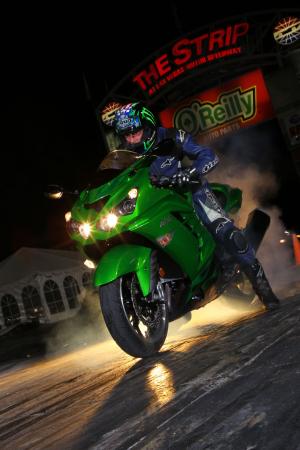 I made sure to heat the tire fully in the burnout box before my first official timed run. As I eased forward into the staging zone, I felt the eyes of the assembled journalists, Kawasaki engineers and Gadson all tuning in to see if I could handle the pressure and pull off a clean and quick run. The anxiety ratcheted up as I held the revs at 3200 rpm as the Christmas tree lights counted down.
I made sure to heat the tire fully in the burnout box before my first official timed run. As I eased forward into the staging zone, I felt the eyes of the assembled journalists, Kawasaki engineers and Gadson all tuning in to see if I could handle the pressure and pull off a clean and quick run. The anxiety ratcheted up as I held the revs at 3200 rpm as the Christmas tree lights counted down. I released the clutch as quickly as I dared and was pleased to feel grip from the rear tire driving me forward as I balanced a small wheelie with the throttle. I could hear the traction control kicking in as the revs climbed, and I was praying that it would quickly hook up as redline approached. The shift light flashed as I got my foot to the shifter for a deft gear change, but I could again hear TC kicking in at the top of second gear. After getting into third, I was just stretching the throttle cable while piling on speed, and the rest of the run went smoothly.
The result was a 10.00 ET, short of the 9-second run I thought I’d need to outgun the nine other motojournos. Three of them had made 9-second passes earlier in the day, and they all had yet to make their competition runs. I had one more shot at a 9, but a 10.06 was the best I could do. I had beaten three editors who had run before me, but now I had to wait for six others.
Several came close to besting my ET, but thankfully they all failed, leaving me as quickest editor at all three ZX-14 press introductions!
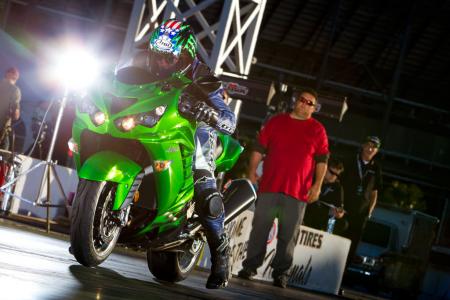 Here’s Duke on his way to capturing competition glory for his loyal MO readers! Here’s Duke on his way to capturing competition glory for his loyal MO readers! |
As I walked away from the strip quite chuffed by my performance, I reflected back at the wide range of riding environments from the day and how well the ZX-14R performed in all of them. It’s docile when ridden around town, smooth and comfy on the highway, and trustworthy and obedient on a twisty road.
The same might also be said about some other sportbikes, but none of them can touch the phenomenal dragstrip prowess of the 14R. In my book, it’s now clearly the king of all hyperbikes.
Like all things regal, the ZX ain’t cheap. It now starts out at $14,699, an $1100 increase over the MSRP in 2011, in your choice of Metallic Spark Black or Candy Surf Blue. An extra $200 will get the Golden Blazed Green version with flame graphics, color-matched side fins and cockpit cowling, and wheels with machined edges.
You’re sure to be noticed on the ZX-14R, whether at the coffee shop or in the winner’s circle.
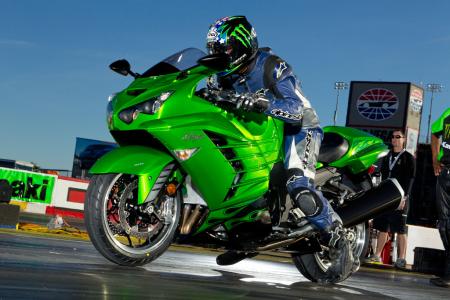 Kawasaki’s ZX-14R launches like a Tomahawk missile into the record books as the fastest-accelerating production streetbike ever made. Kawasaki’s ZX-14R launches like a Tomahawk missile into the record books as the fastest-accelerating production streetbike ever made. |



 8:35 AM
8:35 AM
 Unknown
Unknown


 Posted in:
Posted in: 




0 comments:
Post a Comment